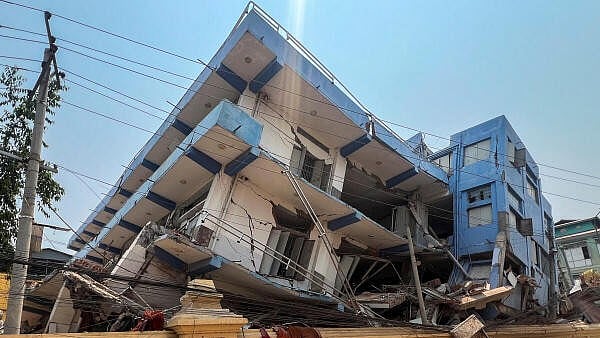
Aftermath of strong earthquake, in Mandalay
Credit: Reuters Photo
By Ruth Pollard
Myanmar’s generals have a choice to make following Friday’s 7.7-magnitude earthquake.
They can repeat the mistakes of 17 years ago when they refused to allow international help after Cyclone Nargis tore through the country, leaving 140,000 dead, or facilitate the free flow of urgent assistance.
Determined to keep Myanmar closed to the world, the junta blocked international relief efforts by banning foreign boats and aircraft from delivering supplies and delaying visas for aid workers in the first few critical weeks after the 2008 disaster. It cannot afford to take the same path this time. Modeling from the United States Geological Survey indicates that more than 10,000 people may have died in the quake, and that estimated economic losses could exceed the nation’s gross domestic product.
So far, the generals appear to be allowing some assistance in, although we are yet to see whether it reaches areas held by the anti-junta resistance. Severely limited internet access means there is little information about the true death toll other than the official tally of 2,056, with more than 3,900 injured.
That Myanmar is in the midst of a civil war is complicating rescue efforts and the distribution of aid. The regime, which took power in a coup in 2021, controls less than a quarter of the country.
India is airlifting a mobile army hospital to the city of Mandalay — the epicenter of the earthquake — along with a team of medics and tons of relief supplies. China, Russia, Israel and the UK are also providing assistance, while the Association of Southeast Asian Nations said teams from Indonesia, Malaysia, Singapore, Thailand and Vietnam had been deployed. President Donald Trump’s cuts to USAID have reportedly delayed and restricted help from America.
The junta’s acceptance of aid is a significant step, and one that the international community should leverage to pry the doors open further. They also must prevent the regime from exploiting the assistance for its own gain.
Ironically, it was (in part) the junta’s decision in 2008 to eventually allow in foreign aid to deal with the cyclone’s aftermath that led to Myanmar’s gradual opening up, and the eventual election of pro-democracy forces in 2015. Citizens will be hoping something similar happens now.
Anti-junta groups and ethnic armies now hold the bulk of the territory, along with important infrastructure projects including Chinese-funded oil and gas pipelines and parts of the 1,400-kilometer (870-mile) highway that runs from the northeastern Indian state of Manipur through Myanmar to Mae Sot in Thailand.
The National Unity Government, which represents the ousted civilian administration, initiated a two-week ceasefire in quake-hit areas to allow aid to reach victims. It doesn’t look like the junta will do the same — instead its warplanes continued to conduct airstrikes near the disaster zones, taking advantage of the chaos to try and gain a foothold against rebel armies.
China, India and Thailand — Myanmar’s three biggest neighbors — have an important role to play, as does the United Nations, which estimates that 20 million people have been affected by the quake and the 5.1 magnitude aftershock that followed Sunday. The European Union, Britain, Australia and New Zealand, among others, have announced millions of dollars in aid. The key will be how this is distributed and whether pressure from donor nations and relief groups can convince the junta to give up its four-year-long war against its citizens.
Beijing, in particular, cannot be happy with the recent chaos on its border, where Myanmar’s army has clashed with armed resistance groups, forcing refugees to flee into China. It’s unclear whether a Beijing-mediated ceasefire agreement that came into effect in January will hold. Rather than prop up the junta, China should support the peace process in other parts of the country that would encourage a stable environment and help protect its investments. This is also a chance to prove its credibility as a global peacemaker, a role it has shown ambitions to play in Ukraine and elsewhere.
The Myanmar army, or Tatmadaw as it’s known, has perpetuated war on multiple fronts since the nation won independence from British rule in 1948. The earthquake has only exacerbated the humanitarian crisis born out of this generations-long conflict. Even before it hit, around a third of the population was in need of humanitarian assistance, while the civil war had displaced more than 3.5 million people, including some 1.6 million in the crisis-struck areas.
There is precedence for a natural disaster helping to end a long-running conflict. The Acehnese national army — the armed wing of the Free Aceh Movement in Indonesia — demobilized and disbanded a year after the 2004 Indian Ocean earthquake and tsunami destroyed much of the province, ending a 30-year separatist insurgency.
Both Cyclone Nargis and the tsunami have provided us with a roadmap, however imperfect. Myanmar and its backers should use it.